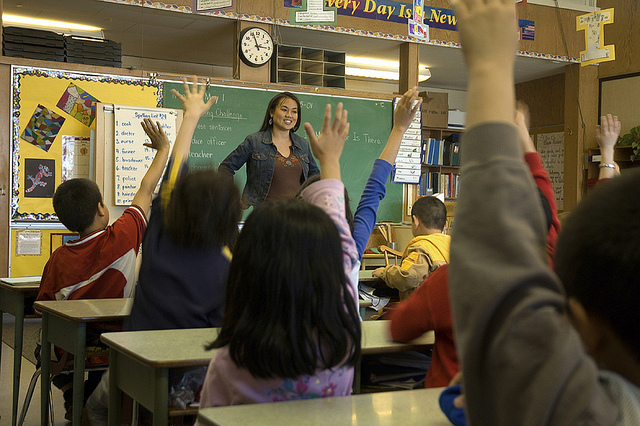Photo above by www.audio-luci-store.it on Flickr Creative Commons
By Margaret Sessa-Hawkins
All the benefits for pre-kindergarten education touted by the Democratic candidates for governor can be easily lost in just a year or two if there isn’t strong follow-up in kindergarten and the early grades, experts and studies show.
As MarylandReporter.com reported Thursday, research into pre-K programs has shown very promising results on its potential to mitigate the achievement gap. But without quality K-12 programs, the benefits gained from pre-K programs can be reversed by as early as first grade.
“High quality pre-K is a necessary component of the effort to close the achievement gap,” said Jason Botel of advocacy group MarylandCAN (Campaign for Achievement Now). “It can’t be the only component, though, because if you have high quality pre-K and low quality K-12 that work can be undone.”
The odds that those benefits will be undone is especially high. Students in the U.S. living in poverty, as well as minority students, have been found to attend the lowest-achieving schools. Likewise, studies have found that these same students have less access to effective and experienced teachers, with one study ranking the U.S. 42 out of 46 developed countries in providing an equal distribution of skilled teachers to varied groups of students.
Maryland works on achievement gap
Maryland, however, has worked hard to address the problem of the achievement gap that exists throughout K-12 education.
“We have tried to make sure there are rigorous courses in every school,” Bill Reinhard, spokesman for the Maryland State Department of Education said. “Advanced Placement courses used to be in certain schools, now they are in every school and it’s growing. We’ve also slowly been strengthening the rigor of our standards. You have to continually raise the bar for students.”
These efforts have proved fairly successful. In the past few years, Education Week ranked Maryland second in the nation for closing the 4th grade reading gap, and 11th in the nation for closing the 8th grade math gap. However, Reinhard also stresses the importance of funding in helping Maryland’s progress.
“It’s a bipartisan issue,” Reinhard said. “Maryland supports its schools. About 12 years ago we had the Bridge to Excellence in Education Act [Thornton aid]. That added money to the budgets of every school in the state, and it was wealth-equalized so that a school district with a lower tax base got more money. It’s been a really important, really successful plan in Maryland.”
Democratic candidates have plans
All three Democratic candidates for governor have centered their education plans around the goal of reducing the achievement gap.
In order to do this, Anthony Brown has proposed establishing an Office of Educational Disparities and Opportunities, expanding career and technology education (CTE), expanding wrap-around programs, and establishing a minority teacher scholarship fund. According to Brown’s website, his initiatives will fund themselves, as responsible investment in pre-K and CTE will reduce costs to the state overall.
Heather Mizeur’s plan for K-12 education involves expanding after school and summer school programs, renewing commitment to fund public education by convening a “Thornton 2.0” commission, and shifting education away from high stakes testing.
Doug Gansler would create grants to incentivize schools to engage with students and families learning English, create a data system to monitor students throughout the education system, create a teacher mentoring program, expand wrap-around programs, and enlist a volunteer corps to support Maryland’s most at-risk students. Gansler proposes funding his plan by diverting gambling revenue, and seeking a temporary waiver from the federal Department of Education so that Maryland will not have to engage in standardized testing during that time and will instead be able to use the money to fund education programs.
Republican proposals
Rather than focusing on the achievement gap, the Republican candidates’ plans to center on freeing education from government control. David Craig, former teacher and school administrator, has promised to repeal Common Core, reduce the administrative budget for education and pass those savings onto schools. Charles Lollar would institute more vocational training and put a moratorium on Common Core until teachers and parents have debated it and Ron George would fund a Children’s Zone in Baltimore similar to the ones in New York, create interim charter schools for high immigration zones, and fund students to attend private schools. Larry Hogan does not have an education plan up for public viewing on his website.
Although the Maryland State Education Association has endorsed Anthony Brown’s plan, they say that when comparing the political parties, the Democratic plans in general are more in line with the priorities necessary to close the achievement gap.
“That sort of holistic approach to pre-K, K-12, and college readiness has been something all Democratic candidates have been talking about,” said Sean Johnson, director of legislative and political affairs for MSEA . “I think by and large the Democratic candidates fall much more in-line with the ideals of public education.”
However, for many, the sheer fact that there is so much focus emerging on the achievement gap is progress in helping to get it closed.
“I think the conversation about the fact that there is a gap is a major part of it getting closed,” said Mychael Dickerson, spokesperson for Baltimore County Public Schools said. “If you have a school that has 84% graduation rate overall, but only 50% for African Americans you can celebrate that overall number, but what are you going to do about the 50%? In Maryland I think we are digging farther down into the numbers to see what’s going on in the sub-levels and see if we can’t raise those kids.”





Recent Comments